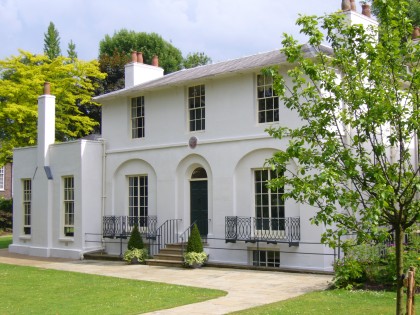
Keats’s copy of Milton’s Paradise Lost. © Keats House
Keats House prepares to reveal Keats’ treasured copy of Milton’s Paradise Lost and explore the relationship between the two great English poets
For students of literature at least, opening a book to find the margins covered in a proliferation of ink notes with salient passages underlined with an indelible pen can be an infuriating thing.
Yet in the 19th century such ‘marginalia’ was considered an important form of literary expression and a route to understanding literary works and sharing views about them. And when the marginalia is by the hand of a great poet like John Keats and the book in question is Keats’ treasured copy of Milton’s Paradise Lost, the sins are forgiven and it becomes a different matter altogether.
more like this
Keats’ extensive notes in his well-thumbed copy of the great epic poem reveal an intense study of Milton at a time of his life and career when the young poet was particularly receptive to learning from the finest of their craft.
Paradise lost was a kind of Bible to the Romantics and that most romantic of them, Keats, made no disguise of his love of the poem, riddling his copy with clues, thoughts, emotional reactions and evidence of Milton’s influence on his work.

Courtesy Keats House .

Eve in Paradise from Paradise Lost. Courtesy Keats House
The treasured book is to revealed to the public as the centrepiece of a new exhibition at the younger poet’s former home in Hampstead, Keats House, the Georgian mansion where he wrote some of his most celebrated poetry.
The impact of Milton’s dense visual and rich sensuous imagery is evident in Keats’s own epic poems, Hyperion and The Fall of Hyperion and the exhibition examines Keats’s notes to reveal patterns of thought, influential subjects and imagery which can be detected in these and other works.
Specifically, Keats is drawn to themes of loss, suffering and mortality. He highlights Eve’s sadness when leaving Paradise and notes passages about separation from loved ones – a dominant feature in Keats’s own life.
On the pages of his copy of Paradise Lost, Keats writes, “Milton in every instance pursues his imagination to the utmost…he sees Beauty on the wing, pounces upon it and gorges it to the producing his essential verse…” Elsewhere he gushes with the enthusiasm of the literature undergraduate. “The light and shade – the sort of black brightness…the thousand melancholies and Magnificences of this Page – leaves no room for anything to be said theron, but : ‘so it is’-.”

Courtesy Keats House.

Courtesy Keats House.
The leather-bound copy of Paradise Lost owned by Keats was published in 1807 in two volumes by booksellers W. and J. Deas and it is believed Keats read the poem with his friend and neighbour Charles Wentworth Dilke.
When he left London for Rome, Keats gave both volumes to Mrs Dilke and they remained with her family before being part of its eventual bequest to Keats House.
In early 1820, Keats had shown signs of consumption, and died in Rome a year later, at just 25 years old, leaving behind some of the most famous and loved poems in the English language.
“A direct channel to Keats’ thoughts”
Born in London in 1795, Keats was orphaned young and, after leaving school at 14, trained as an apothecary surgeon. Though not wealthy, he gave up medicine to dedicate his life to poetry. His first sonnets appeared in 1816 and his first book of poems followed a year later. Unkind critics, the loss of his brothers and his frustrated love for Fanny Brawne were the painful background to his creativity and the outpouring of poetry he produced in 1819 is said to be among the finest in the English language.
Describing Keats’s copy of Paradise Lost as a “true treasure” Graham Packham, chairman of London’s City’s Culture, Heritage and Libraries Committee, says the book will offer visitors a “direct channel” to Keats’ thoughts.

Courtesy Keats House.

John Keats, 1819 by Joseph Severn. Courtesy Keats House
“His notes are so detailed that we are lucky to have something of a book within a book” he adds. “Research reveals patterns, subjects, themes and motifs that would later appear in Keats’s own work. Keats and Milton are literary greats and we are pleased to be celebrating them together.
“Keats was at his most prolific and at a creative height while he lived here and it was here that he would have read Paradise Lost, so this is an entirely fitting and powerfully atmospheric setting for the exhibition and an opportunity to lose yourself in the works of both great poets.”
Keats House, originally known as Wentworth Place, was built in 1815-16 for the Dilke family and Charles Brown. From the outside, it appears to be one villa, but the interior was divided into two homes. Keats lodged with Brown from December 1818.
The following year, the Dilkes moved away and Fanny Brawne and her family moved into their side of the house, inspiring Keats’s greatest happiness and greatest work. After Keats left, Wentworth Place was converted into a single dwelling and extended. It was saved from demolition in 1920 and in 1925 became a museum dedicated to Keats. With its restored period Georgian interiors and Keats related treasures today it is one of the most atmospheric literary house spaces.
The December exhibition coincides with the house being dressed for Christmas.
Keats and Milton: Paradise Lost runs from December 6 2017 to October 14 2018.
venue
Keats House
London, Greater London
Keats House is where the poet John Keats (1795-1821) lived from 1818 to 1820. Here he wrote some of his best known poetry, including "Ode to a Nightingale". The house is a Grade 1 listed building set in a peaceful garden in Hampstead. It has been open to the public…


